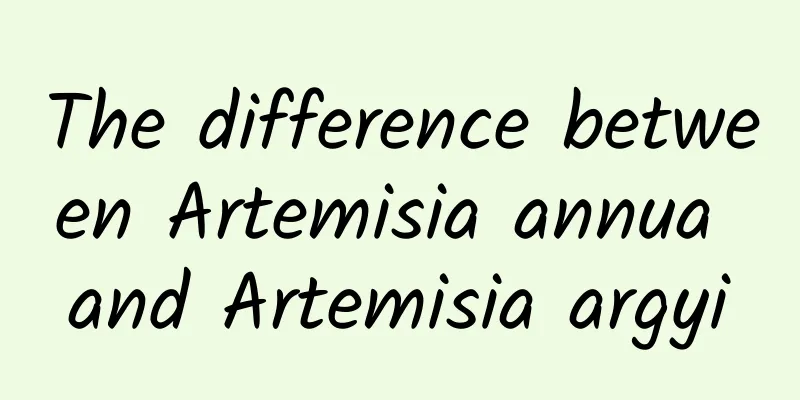The difference between Artemisia annua and Artemisia argyi

|
Sometimes when the weather is not good, people will get sick, such as coughing and sore throat. Although they are all minor problems, they often make us feel uncomfortable for a few days, so we need to master some common medical knowledge; of course, we don’t have to buy those professional cough medicines or antiviral medicines. Some Chinese herbal medicines can relieve pain just by boiling them in water. Today I want to introduce to you the difference between Artemisia annua and Mugwort. Let’s follow me to learn about it. It is very easy to confuse mugwort and wormwood. Today I will talk about the difference between the two. 1. Different effects: Artemisia white is a species of Artemisia grandis, a plant of the Asteraceae family. It is mainly used to treat swelling, heat, cough, sore throat, jaundice caused by cold and dampness, dysentery, gonorrhea, rheumatic arthralgia, hematemesis, hemoptysis, bleeding from trauma, scabies and malignant ulcers. Artemisia annua is a perennial herb or slightly semi-shrub with a strong fragrance on the main stem. The fruit season is from September to October. Wolf grass is used as medicine, which has the effects of relaxing the meridians, removing dampness, removing cold, promoting blood circulation, reducing inflammation, relieving asthma, relieving cough and reducing phlegm, nourishing the fetus, and resisting allergies. 2. Different appearances: Artemisia annua is an annual or biennial herb, 50-150cm tall. The main stem is single and narrowly fusiform. The lower part of the stem is slightly woody, with obvious longitudinal ridges and multiple branches. The stem and branches are covered with milky white soft hairs. The leaves are symbiotic; the leaf stems are 1-4 cm long; the lower and middle leaves are broadly ovate or broadly ovate, 4-8 cm long, 3-6 cm wide, two to three times palmately divided, with 2-3 lobes on each side, the lobes are often irregularly palmately divided or deeply divided, the lobes are linear or strip-lanceolate, 2-10 mm long, 1-2 mm wide, obtuse or acuminate at the apex, with small palmately broken pseudobracts at the tip. The upper leaves and bracts are pinnately divided or disintegrated, oblate-lanceolate or lanceolate, and sessile. The inflorescence of Artemisia annua is elliptical, 2.5-3 (-3.5) mm in diameter, sessile or nearly sessile, with several to more than 10 inflorescences arranged in small racemes or compound racemes on the branches, and generally forming narrow, spire-shaped panicles on the stems. The inflorescence heads are inclined downward when the flowers wither; the leaves are thick and papery, covered with grayish white short soft hairs on the upper side, with milky white glandular dots and small grooves, and densely covered with grayish white spider-like dense hairs on the back. The basal leaves have long petioles and wilt during flowering; the leaves below the stem are nearly ring-shaped or broadly ovate, deeply palmately divided, with 2-3 lobes on each side, the lobes are elliptical or obovate-oblong, each lobe has 2-3 small teeth, the main and lateral veins on the back are mostly dark red or rusty when dry, and the leaf stem is 0.5-0.8 cm long. Artemisia has a capitate inflorescence, which is mostly hemispherical or nearly spherical, 3-6mm in diameter, with short stalks and linear bracts at the tip. It is arranged in racemes or compound racemes on the branches, with 3-4 layers of involucres. The surface and middle and upper layers are covered with grayish-white soft hairs or nearly hairless on the back. The midrib is green, the edges are narrowly membranous, and the inner layer is membranous. The capitula is hemispherical with milky white stipules; the male flowers are 2(-3) layers, 20-30 in number, with 2-4 teeth on the fringe of the corolla, the style is linear and has two forks at the apex; the bisexual flowers are double-layered, 80-120 in number, the corolla is tubular, the attachment above the anther is pointed, long triangular, with a short pointed mouth at the apex, the style is the same length as the corolla, forked at the apex, truncated at the fork end, and has eyelashes. Achenes long ring-shaped. Flowering and fruiting period is June to October. Artemisia annua is a perennial herb or slightly semi-shrubby green plant with a strong fragrance on its main stem. The main stem is obvious, slightly thick and long, with a diameter of up to 1.5 cm, and many main roots; horizontal rhizomes and nutrient branches often appear underground. Stem single or very few, 80-150 (-250) cm high, with obvious longitudinal ridges, dark brown or gray-brown, slightly woody at the tip, herbaceous at the top, and with very few short branches, 3-5 cm long; stems and branches are covered with dark gray spider-like soft hairs. |
>>: The efficacy and usage of kidney-tonifying fruit
Recommend
Cao Cao VS Liu Bei, where should the male god Guan Yu go?
Mixed Knowledge Specially designed to cure confus...
DNA map unlocks new insights into brain development: Mental illness may originate in the fetal period
Tuchong Creative The human brain is one of the mo...
Asian Winter Science Popularization Issue 5丨The "Breathing Magic" in Ice and Snow Sports and the "Healthy Code" of Cardiovascular Diseases
First instance: Sun Yu Second trial: Suo Yingxing...
What are the effects and functions of mixing Panax notoginseng and American ginseng?
The combination of Panax notoginseng and American...
"Zu Chongzhi No. 3" is launched! How far are we from using quantum computers?
Recently, Chinese scientists have made a major br...
The efficacy and function of duck foot polygonum
The traditional Chinese medicine Polygonum multif...
How to eat wolfberry for better results?
I believe that wolfberry is definitely good news ...
What are the effects and functions of golden edge grass?
The plant of golden-edged grass generally grows i...
Why is the Yellow River named Huang? A brief discussion on the origin of the name "Yellow River"
The Yellow River, which has been surging for thou...
The difference between ginseng and red ginseng
There are still some differences in the effects o...
Is this the first time I heard that chestnuts can be eaten raw? Yes! And it’s really delicious!
When it comes to chestnuts, many people first thi...
How long can the plaster last?
Plaster is a common medicine when we treat diseas...
49 million years ago, a plant overran the frozen Earth
Global climate change has become the biggest obst...
What are the functions of kiwi root?
Not only does the flesh of many fruits have nutri...









